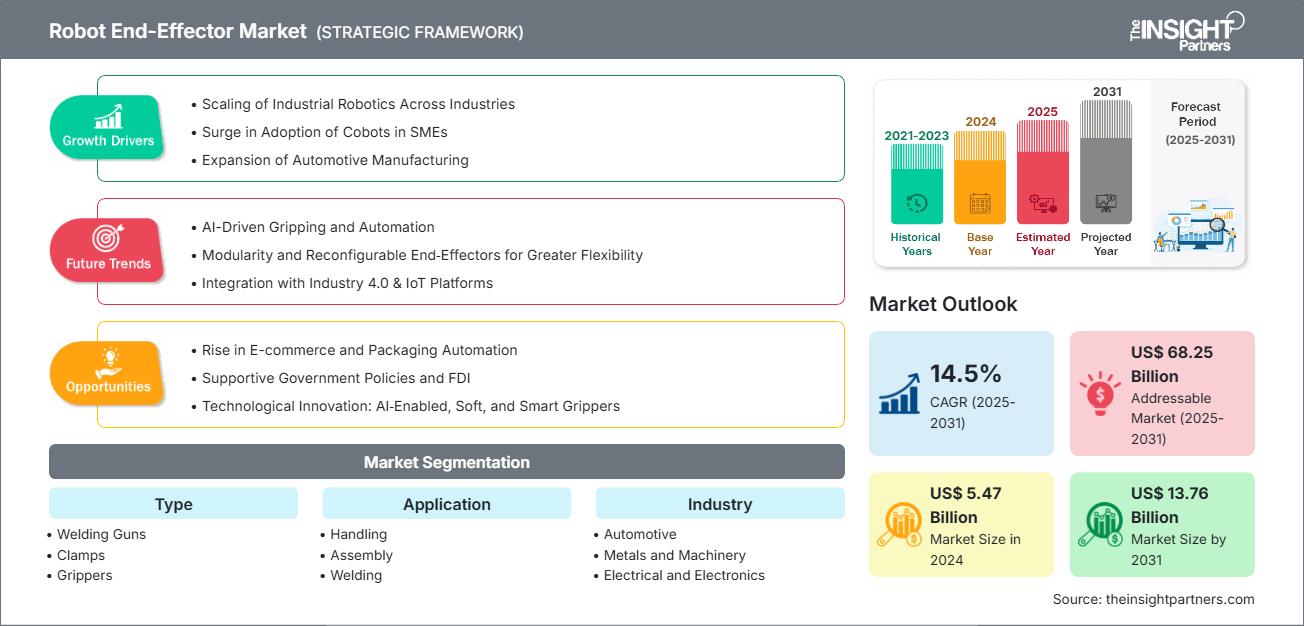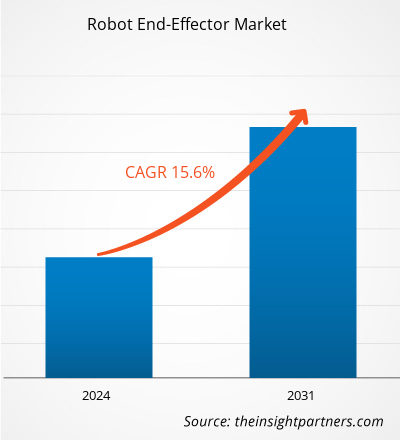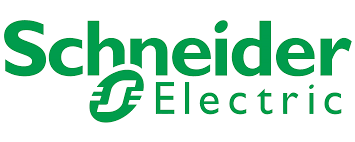The robot end-effector market size is expected to reach US$ 5.47 billion in 2024 and is expected to reach US$ 13.76 billion by 2031. The robot end-effector market size is estimated to register a CAGR of 14.5% during 2025–2031.
Robot End-Effector Market Analysis
The market for robot end-effectors is steadily growing due to the increasing automation in industries, advancements robotics, and the usage of collaborative robots (cobots) in the workplace. A growing number of applications are demanding different styles of end-effectors that are flexible, capable of high precision and high levels of specificity. Growing demand for diverse end-effectors, especially in the automotive, electronics and logistics sector, has prompted manufacturers to invest vigorously in smart grippers, vacuum cups and tool changers. Advancements in technology in the field, along with more integration of sensors and AI-based control, have expanded the capabilities of end-effectors for example adaptive gripping, and real-time feedback of gripping performance. There are very strong opportunities for growth in the industry in the dominate for-cast period due to a growing trend towards modularization, and customizable end-effector solutions.
Robot End-Effector Market Overview
End-effectors are the devices (or tools) that work directly on the workpieces of the robotic system (e.g. grippers, welding guns, vacuum cups), and helps in automation methods in many different domains. As companies look for more flexibility and effectiveness, the demand for multi-faceted, intelligent end-effectors is incraesing. End-effectors allow robots to perform tasks that require more complexity, accuracy, and compatibility to work alongside humans without restrictions. The rate of adoption is quite strong for all end-effectors, particularly in automotive manufacturing, electronics assembly, warehousing, and health care. As Industry 4.0 evolves, there are developing products for smart, connected end-effectors that increasing productivity, while decreasing downtime.
Customize This Report To Suit Your Requirement
You will get customization on any report - free of charge - including parts of this report, or country-level analysis, Excel Data pack, as well as avail great offers and discounts for start-ups & universities
Robot End-Effector Market: Strategic Insights

- Get Top Key Market Trends of this report.This FREE sample will include data analysis, ranging from market trends to estimates and forecasts.
You will get customization on any report - free of charge - including parts of this report, or country-level analysis, Excel Data pack, as well as avail great offers and discounts for start-ups & universities
Robot End-Effector Market: Strategic Insights

- Get Top Key Market Trends of this report.This FREE sample will include data analysis, ranging from market trends to estimates and forecasts.
Robot End-Effector Market Drivers and Opportunities
Market Drivers:
- Growth within Industrial Automation As industries are trying to automate for higher productivity, robotic end-effectors are emerging for industrial applications such as welding, assembly, and material handling. The rise of smart factories in manufacturing and logistics is coinciding with increases in demand for advanced end-effector technologies to enhance performance, speed, and productivity.
- Increase in Collaborative Robots (Cobots) Collaborative robots require end-effectors to be lightweight, safe, and versatile. The expansion of collaborative robots in most small and medium-sized enterprises (SMEs), and into non-traditional sectors, is creating growing demand for an easier and more flexible end-effector that includes built-in sensors and compliance. Their versatility allows usefulness in a greater variety of contexts, leading to increased usage in a wide range of working environments.
- Growth in Demand for Customization and Versatility There is a significant and growing need from manufacturers for customized end-effectors that can work with different shapes, materials, and fragile components. The electronics, food, and healthcare industries have a rising demand for customized end-effectors to allow for greater efficiencies and faster job changeovers. Versatile end-effector solutions that allow for quick job changeovers can revolutionize some areas of production, where customization could become a key driver of industry growth in very competitive environments.
Market Opportunities:
- Expanding into Emerging Markets Emerging markets in Asia, Latin America, and Africa offer opportunities for the adoption of end-effectors. Regionally, as these markets put resources into automation to increase productivity, the potential for local industries to integrate robotics is largely untapped.
- Integration of AI and Smart Sensors The integration of AI and advanced sensing technologies into end-effectors creates the possibility of adaptive gripping, real-time decisions, and error recovery. Offering these capabilities will open new markets where precision is required (i.e., electronics and pharmaceuticals). Smart end-effectors would be able to adjust automatically to varying objects increasing efficiencies and diminishing programming time and downtime.
- E-commerce and Logistics Growth The rapid growth of e-commerce has increased the demand for automation in warehouses and distribution centers. Those end effectors used in pick-and-place, sorting, and packing operations offer capabilities to meet consumer expectations for timely deliveries and order accuracy. This offers a high-growth potential market for suppliers supplying end-effectors systems that are scalable, rapid and robust.
Market Trends:
- Modular and Plug-and-Play Designs There is a clear trend towards modular end-effectors for many applications to be easy to install, upgrade or switch between applications. The plug-and-play end-effector design reduces integration time and lowers training needs. The modular and plug-and-play end-effectors are ideal for manufacturers that want flexibility and a quick time to value across production lines.
- Concerning Human-Robot Collaboration End-effectors are becoming more developed for safe and intuitive interface between human workers and robots. Soft grippers, compliant mechanisms, and interfaces with force feedback can improve human-robot collaboration. This trend toward human-robot collaboration strengthens the expansion of cobots, and encompasses a wider variety of robot deployment opportunities in less structured, human-centric environments.
- Miniaturization for High Precision Tasks In electronics, and medical device industries, the demand for handling small and fragile components drives the design of miniature end-effectors. Miniature end-effectors provide precision and dexterity for applications that require significant movement such as micro-assembly, surgical, and other fine manipulation tasks while adhering to the trends of miniaturization, and high-performance automation.
Robot End-Effector Market Report Segmentation Analysis
The robot end-effector market is divided into different segments to give a clearer view of how it works, its growth potential, and the latest trends. Below is the standard segmentation approach used in industry reports:
By Type:
- Welding Guns As robot end-effectors, welding guns are used in a number of applications in the automotive and heavy machinery sectors. They allow welding with a high degree of precision in the assembly line, ultimately improving end-product quality and lowering labor costs. The popularity of welding guns is increasing because of more automation in metal-based processes as well as the need for consistent high-speed welds.
- Grippers Grippers are used in a number of functions including pick-and-place applications, logistics, packaging, and assembly line applications. Grippers increase productivity by allowing the robot to manoeuvre objects of various shapes and sizes. With the growth in e-commerce and warehouse automation, there is an increased need for grippers to accomplish tasks requiring speed, precision, and limited manual handling.
- Tool Changers Because tool changers provide robots the ability to swap to different tools automatically, they expand on the flexibility of robots. Tool changers decrease downtime and increase the flexibility of the robotic system in fields like aerospace, electronics, and automotive. Tool changers are gaining traction as manufacturing transitions to increased flexible automation systems.
- Clamps Clamps are used to properly hold down work pieces, while machining, welding, or assembling, safely and securely. In precision operations where stability and safety are valued, clamps are an important end effector. The increased focus on automated manufacture, and CNC operations, is enhancing the need for robotic clamps in industry.
- Suction Cups Suction cups are commonly employed for the handling of fragile or lightweight materials like glass, plastic, or paper. Vacuum-based suction is used in some industries (such as food packaging and electronics) where materials must be handled quickly and safely. Due to suction cups non-damaging action, they are great for fragile and lightweight products and cleanroom applications.
- Vacuum Vacuum end-effectors are now commonly used for the handling of flat or porous objects in the packaging, warehouse, and material handling industries. Their adhesion is fast, as is their release. Vacuum end-effectors enable high-speed workflow, which benefits the increasing adoption of robotic logistics applications.
- Others The other segment includes specialized or hybrid end-effectors that are designed for niche applications like polishing, painting, and using ultrasonic cutting. As automation continues to evolve in industries, customized end-effectors can be developed and adapted to uniquely-efficient operational processes.
By Application
- Handling
- Assembly
- Welding
- Dispensing
- Processing
- Others
By Robot Type
- Traditional Robot
- Collaborative Robot
By Industry
- Automotive
- Electrical and Electronics
- Metals and Machinery
- Food and Beverages
- Retail and E-commerce
- Others
By Geography
- North America
- Europe
- Asia Pacific
- South & Central America
- Middle East & Africa
Robot End-Effector Market Regional Insights
The regional trends and factors influencing the Robot End-Effector Market throughout the forecast period have been thoroughly explained by the analysts at The Insight Partners. This section also discusses Robot End-Effector Market segments and geography across North America, Europe, Asia Pacific, Middle East and Africa, and South and Central America.
Robot End-Effector Market Report Scope
| Report Attribute | Details |
|---|---|
| Market size in 2024 | US$ 5.47 Billion |
| Market Size by 2031 | US$ 13.76 Billion |
| Global CAGR (2025 - 2031) | 14.5% |
| Historical Data | 2021-2023 |
| Forecast period | 2025-2031 |
| Segments Covered |
By Type
|
| Regions and Countries Covered | North America
|
| Market leaders and key company profiles |
|
Robot End-Effector Market Players Density: Understanding Its Impact on Business Dynamics
The Robot End-Effector Market is growing rapidly, driven by increasing end-user demand due to factors such as evolving consumer preferences, technological advancements, and greater awareness of the product's benefits. As demand rises, businesses are expanding their offerings, innovating to meet consumer needs, and capitalizing on emerging trends, which further fuels market growth.

- Get the Robot End-Effector Market top key players overview
Robot End-Effector Market Share Analysis by Geography
The growth of the robot end-effector market in North America is accelerating rapidly as companies invest aggressively in industrial automation solutions, adopt advanced manufacturing techniques, and concentrate R&D resources on robotics. Asia Pacific will experience tremendous growth as rising industrial activity, supportive government programs, and low-cost manufacturing bolster a new era of robotics across the hemisphere. In Europe, now the leading market, growth has been driven by a commitment to R&D and innovation, and safety standards, and widespread adoption of collaborative robots across nearly all sectors.
The robot end-effector market displays variation by region in terms of end-user adoption as well as innovation, based on the readiness for automation, workforce availability and dynamics, and trajectories and growth of their respective industry sectors. Below is a summary of market share and trends by region:
1. North America
- Market Share: Remains a large share in the world due to early adoption of the technology
- Key Drivers:
- Large number of robotics manufacturers and integrators
- Large amount of R&D spending in automation technologies
- Use of cobots is expanding in the automotive and aerospace sectors.
- Trends: Focus on precision end-effectors for high end applications and increased demand for smart grippers.
2. Europe
- Market Share: Remains a stable, and mature market
- Key Drivers:
- Regulated safety standards with the newest automation with the use of cobots
- Strong automotive and electrical manufacturing base
- Integration of Industry 4.0 technologies.
- Trends: Surge of electric vehicle manufacturing will raise demand for welding and assembly end-effectors.
3. Asia Pacific
- Market Share: Fastest growing market in the world.
- Key Drivers:
- Fast and cheap manufacturing and a healthy rate of industrialization
- Government interventions in automation - "Made in China 2025"
- Dynamic growth in consumer electronics and automotive industries. .
- Trends: Increased use of multi-functionality and lightweight end-effector technology to facilitate flexible automation.
4. South and Central America
- Market Share: Emerging market with growing adoption in the industrial sector
- Key Drivers:
- Growing demand for automation in food & beverage and packaging industries
- Demand for cheaper alternatives to labor costs
- Growing activity of international vendors of robotics.
- Trends: Adoption of basic end-effectors such as grippers and suction cups in small-scale industries.
5. Middle East and Africa
- Market Share: Developing market with growing investment interest
- Key Drivers:
- Expanding logistics and warehousing sectors
- Growth in oil & gas automation and smart infrastructure
- Government initiatives in industrial diversification.
- Trends: Adoption of robotic systems in non-traditional sectors such as mining and utilities drives demand for rugged and durable end-effectors.
Robot End-Effector Market Players Density: Understanding Its Impact on Business Dynamics
High Market Density and Competition
Competition is intense due to established players such as ABB Ltd., SMC Corporation, and KUKA AG. Regional and niche providers such as Festo AG and Co. KG (Germany) and ZIMMER GROUP GmbH (Germany) add to the competitive landscape across regions.
This high level of competition urges companies to stand out by offering:
- Partnership and Collaboration among Market Players
- Acquisition Strategies to Expand Technological Capabilities.
Opportunities and Strategic Moves
- Introduction of Smart and AI-Integrated End-Effectors
- Geographic Expansion into Emerging Industrial Markets
Major Companies operating in the Robot End-Effector Market are:
- ABB Ltd. – Zurich, Switzerland
- SMC Corporation – Tokyo, Japan
- DESTACO – Auburn Hills, Michigan, US
- Festo AG and Co. KG – Esslingen am Neckar, Germany
- Schmalz GmbH – Glatten, Germany
- KUKA AG – Augsburg, Germany
- Piab AB – Danderyd, Sweden
- Staubli International AG – Pfäffikon, Switzerland
- SCHUNK GmbH and Co. KG – Lauffen/Neckar, Germany
- ZIMMER GROUP GmbH – Rheinau, Baden‑Württemberg, Germany
Disclaimer: The companies listed above are not ranked in any particular order.
Other companies analyzed during the course of research:
- Yaskawa Electric Corporation
- OnRobot
- Weiss Robotics
- IPR Robotics
- Shobai Automation Pvt. Ltd.
- Beckhoff Automation GmbH & Co. KG
- igus GmbH
- autonox Robotics GmbH
Robot End-Effector Market News and Recent Developments
- Dassault Systèmes' partnership with KUKA Dassault Systèmes announced its partnership with the global industrial automation and robotics company KUKA to provide manufacturing industries with solutions that meet growing demands in robotics and automation. By expanding customer access to virtual twin technology and enhanced collaboration capabilities, Dassault Systèmes and KUKA, with its newly founded segment KUKA Digital, can unlock opportunities for companies to develop more efficient and adaptable solutions that transform their operations.
- Oxipital AI and Schmalz partnership Oxipital AI and Schmalz extended partnership for automated picking. The longtime collaborators said they will integrate Oxipital AI’s advanced machine vision technology for inspection and picking with Schmalz’s mGrip robotic fingers and vacuum end-of-arm tooling (EOAT). This partnership is expected to deliver next-generation robotic grasping solutions that enhance operational efficiency, reduce labor reliance, and ensure consistent, safe, and profitable production for end customers in the food and beverage industry and beyond.
Robot End-Effector Market Report Coverage and Deliverables
The "Robot End-Effector Market Size and Forecast (2021–2031)" report provides a detailed analysis of the market covering the following areas:
- Robot End-Effector Market size and forecast at global, regional, and country levels for key segments covered under the scope
- Robot End-Effector Market trends, as well as market dynamics such as drivers, restraints, and key opportunities
- Detailed PEST and SWOT analysis
- Robot End-Effector Market analysis covering key market trends, global and regional framework, major players, regulations, and recent market developments
- Industry landscape and competition analysis covering market concentration, heat map analysis, prominent players, and recent developments for the Robot End-Effector Market
- Detailed company profiles
Frequently Asked Questions
What is the current size of the global robot end-effector market?
What are the key factors driving growth in the robot end-effector market?
Which delivery model segment is gaining traction in the robot end-effector market?
Which regions are leading in the adoption of the robot end-effectors?
What are the challenges faced by the robot end-effector market?
Which leading companies are in the robot end-effector market?
Which industries are the primary end-users of the robot end-effector?
- Historical Analysis (2 Years), Base Year, Forecast (7 Years) with CAGR
- PEST and SWOT Analysis
- Market Size Value / Volume - Global, Regional, Country
- Industry and Competitive Landscape
- Excel Dataset
Recent Reports
Related Reports
Testimonials
Reason to Buy
- Informed Decision-Making
- Understanding Market Dynamics
- Competitive Analysis
- Identifying Emerging Markets
- Customer Insights
- Market Forecasts
- Risk Mitigation
- Boosting Operational Efficiency
- Strategic Planning
- Investment Justification
- Tracking Industry Innovations
- Aligning with Regulatory Trends





















 Get Free Sample For
Get Free Sample For